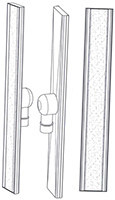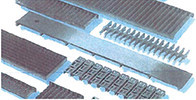Easy Sanitary Solutions: scope of design protection
Easy Sanitary Solutions BV and European Union Intellectual Property Office v Group Nivelles NV. A recent and important decision from the Court of Justice of the European Union (CJEU) has confirmed the position held by the UK Courts that the scope of protection for a registered design extends to the application of the design to any product irrespective of the trade sector.
Easy Sanitary Solutions (ESS) obtained a registered Community design in 2004 as shown in the three views below.

The application indicated the product as shower drains under class 23.02 of the Locarno classification system.
The design was renewed in 2009 but shortly thereafter an application for declaration of invalidity was filed by I-Drain, the predecessor of Group Nivelles NV (Nivelles). Nivelles argued that the design did not fulfil the novelty requirements under the Regulation and nor did the design have sufficient individual character. In support of the application for a declaration of invalidity Nivelles included extracts from two catalogues including the image shown below.

Initially, the design was held to be invalid by the EUIPO but on appeal that decision was overturned. Nivelles successfully appealed to the General Court and the original decision was reinstated. The case came before the CJEU with appeals both by ESS and the EUIPO along with an intervention from the United Kingdom.
EUIPO’s appeal
The EUIPO was concerned at the inference from the General Court’s decision that it should be required to compare the contested design with the prior art and, at its own initiative, consider the combination of several components of the earlier design even when they are disclosed separately. The EUIPO rightly made reference to the decision in Karen Millen Fashions which confirmed that a design could be compared with earlier individual designs but not with an amalgam of specific features or parts of an earlier designs.
The CJEU noted that a design is defined as being “the appearance of the whole or a part of a product resulting from the features of, in particular, the lines, contours, colours, shape, texture and/or materials of the product itself and/or its ornamentation”.
It follows that appearance is the decisive factor when considering a design.
The EUIPO argued that Nivelles had failed to present in its application for a declaration of invalidity, a complete reproduction of the design that was claimed to be an earlier design. The CJEU confirmed, however, that contrary to the General Court’s judgment, the fact that the contested design only exists as a combination of designs is not relevant for the purpose of assessing novelty. Notwithstanding this error by the General Court the CJEU confirmed that its judgment should still hold if its operative part was well founded on other legal grounds. The CJEU confirmed that the design claimed by Nivelles to be earlier was a complete drainage device for liquid waste offered by Blücher and thus this could be used for comparison purposes when considering novelty with the contested design.
The ESS appeal – scope of protection
ESS argued that the General Court was wrong in stating that the “sector concerned” is not limited to that of the product in which the contested design is intended to be applied. They argued that the concerned sector must have a link between the design and the product or products to which the design would be applied. ESS essentially contended that a design’s protection should be limited to designs belonging to a specific sector.
This case is the first time this point had come before the CJEU. Previously, however, in the United Kingdom in the case of Green Lane Products v PMS International in 2008 it was confirmed that the prior art available for attacking validity may come from any sector and not just that of the intended products of the design, subject to the limited exception of prior art that is obscure even in the sector from which it comes.
Finding of the CJEU – confirmation of the UK position
The most important aspect of this judgment was the confirmation from the CJEU that a registered Community design confers on its owner the exclusive right to use the relevant design for all types of products and not only in the product indicated in the application for registration. Accordingly, a Community design cannot be regarded as being new if an identical design has been made available to the public, even if that earlier design was intended to be used in a different sector or for a different product. The sectors in this particular case appear similar to the layperson but the appeal by ESS on the point enabled the CJEU to issue a definitive decision.
Position of the informed user
The court also looked at the position of the informed user. Previous case law has confirmed that the informed user knows the various designs which exist in the sector concerned, possesses a certain degree of knowledge with regard to the features which those designs normally include, and, as a result of his/her interest in the products concerned, shows a relatively high degree of attention when using them.
The CJEU contended, however, that the General Court had erred in requiring that the informed user should have knowledge of the actual product in which the earlier design is incorporated or to which it is applied. This would be incompatible with Article 10 of the Regulation which states that the protection granted by a Community design extends to any design that fails to produce on the informed user, a different overall impression.
In short
This major decision is important in confirming the extent to which protection is afforded to a registered design. An outcome where the scope of that protection was limited to the relevant sector concerned would have had huge consequences for design owners and future filing strategies.
Confirmation that the UK Court’s position in Green Lane Products v PMS International was correct is to be welcomed as it very clearly and unambiguously confirms the novelty requirements throughout the European Union and reinforces the strength of protection afforded to registered designs.
Case details at a glance
Jurisdiction: European Union
Decision level: Court of Justice
Parties: Easy Sanitary Solutions BV and Group Nivelles NV
Citation: Joined Cases C‑361/15 & C‑405/15
Date: 21 September 2017
Full decision: http://dycip.com/easysanitary